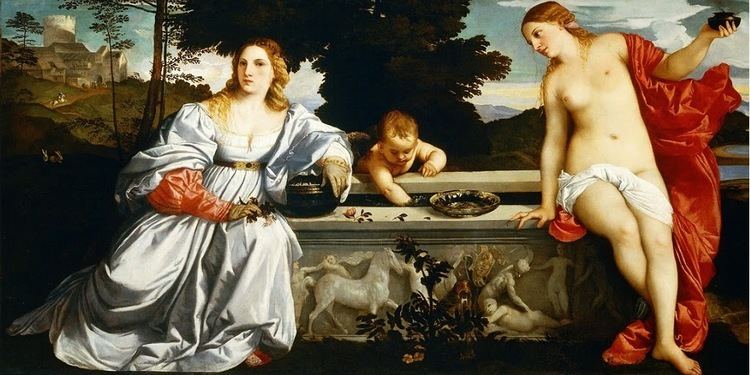Year c. 1514 Media Oil paint | Dimensions 1.18 m x 2.79 m Created 1514 | |
 | ||
Similar Titian artwork, Artwork at Galleria Borghese, Renaissance artwork | ||
Sacred and Profane Love (Italian: Amor Sacro e Amor Profano, also called Venus and the Bride) is an oil painting by Titian, painted c. 1514. The painting is presumed to have been commissioned by Niccolò Aurelio, a secretary to the Venetian Council of Ten (so identified because his coat of arms appears on the sarcophagus or fountain in the centre of the image) to celebrate his marriage to a young widow, Laura Bagarotto. It perhaps depicts the bride dressed in white, sitting beside Cupid and being assisted by Venus in person.
Contents
- Tiziano vecellio paintings amor sacro e amor profano sacred and profane love
- Analysis of the artwork
- History
- Painting materials
- References
Tiziano vecellio paintings amor sacro e amor profano sacred and profane love
Analysis of the artwork
Art critics have made several analyses and interpretations, among them are: Ingenious Love and Satisfied Love; Prudery and Love; the wise and foolish virgins; the dressed Aphrodite Pandemos (left) opposite the nude Aphrodite Urania. or that it contains a coded message about Bagarotto's father's innocence. Nadia Gaus notes that while the title might at first lead one to view the left hand woman as the sacred one, further thought leads to the opposite interpretation: the well dressed woman is Profane Love while the nude woman is Sacred Love. The title itself of the painting is uncertain: in 1693 it was listed as Amor Divino e Amor Profano (Divine love and Profane love).
While the first record of the work under its popular title is in an inventory of 1693, scholars cannot definitively discredit the theory that the two female figures are personifications of the Neoplatonic concepts of sacred and profane love. The art historian Walter Friedländer outlined similarities between the painting and Francesco Colonna's Hypnerotomachia Poliphili and proposed that the two figures represented Polia and Venere, the two female characters in the 1499 romance. A more recent hypothesis declares the clothed figure to be Proserpine the consort of Pluto, and the semi nude her mother Ceres. They are seated on the Fountain Cyane, while the child is Mercury [Paul Doughton] It has been suggested that the scholar Pietro Bembo may have devised the allegorical scheme.
History
The work was bought in 1608 by the art patron Scipione Borghese and is currently housed with other works from the Borghese collection in the Galleria Borghese in Rome. In 1899, the Rothschilds' offer to buy the work from the gallery for 4 million lira (more than the value of the whole Galleria Borghese building and collections, then valued at 3,600,000 Lira) was refused.
Painting materials
The painting was analyzed in 2000 by a variant of x-ray fluorescence spectroscopy which made it possible to identify the pigments used by Titian. The scientists were able to identify lead white, azurite, lead-tin yellow, vermilion and yellow ochre. An illustrated pigment analysis can be found at ColourLex.
